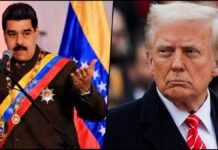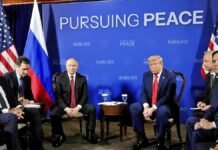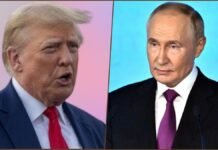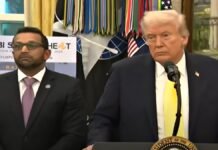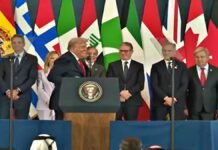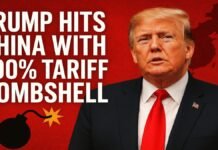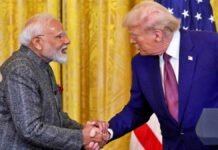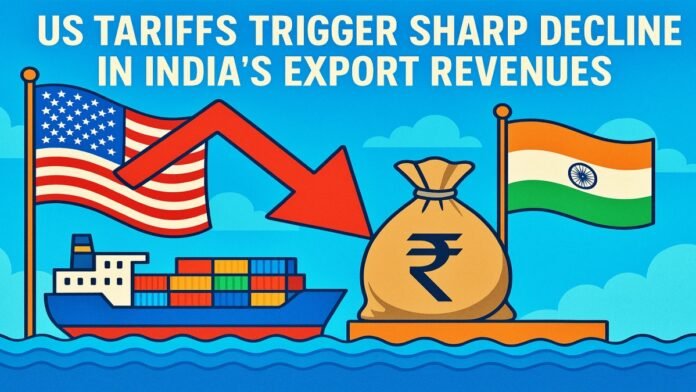
Key Points:
- India’s exports to the US plunged 37.5% between May and September 2025, falling from $8.8 billion to $5.5 billion—one of the sharpest short-term collapses in recent years
- The US imposed escalating tariffs on India starting at 10% in April 2025, rising to 25% reciprocal tariffs, plus an additional 25% penalty for purchasing Russian oil, totaling 50%
- Labor-intensive sectors including textiles, gems and jewelry, chemicals, and agricultural products saw exports drop 33% from $4.8 billion to $3.2 billion
- Smartphone exports crashed 58%, falling from $2 billion in June to $884.6 million in September; pharmaceutical exports declined 15.7%
- India and the US are in advanced stages of finalizing a trade agreement, with Commerce Minister Piyush Goyal confirming negotiations could conclude by fall 2025
- The proposed trade deal could reduce US tariffs on Indian exports from 50% to 15%, while India may rebalance its oil imports toward the US
New Delhi: Despite the close relationship between President Donald Trump and Prime Minister Narendra Modi, ongoing trade negotiations have been overshadowed by punitive US tariffs that have severely impacted India’s export performance. The Global Trade Research Initiative (GTRI), an India-based trade think tank, released an analysis on November 2, 2025, revealing that India’s exports to the American market have fallen for four consecutive months across all sectors.
Tariff Escalation Timeline
The tariff crisis began on April 2, 2025, when the US imposed an initial 10% tariff on Indian goods at the beginning of the fiscal year. The situation deteriorated dramatically by August, when tariffs reached 25% as part of Trump’s reciprocal tariff policy. In the last week of August, the US imposed an additional 25% penalty tariff specifically targeting India’s continued purchase of oil from Russia, despite the ongoing Ukraine conflict, bringing the total to a staggering 50% among the highest tariffs imposed on any trading partner.
Unprecedented Export Collapse
The GTRI analysis compared export performance between May and September 2025 to assess the immediate fallout of these tariffs. In absolute terms, the decline from $8.8 billion to $5.5 billion represents a 37.5% decrease and marks one of the sharpest short-term declines in years. According to GTRI, “Tariffs have not only squeezed India’s trade margins but also exposed structural vulnerabilities across key export industries”.
Labor-Intensive Sectors Bear the Brunt
The Trump-imposed tariffs have particularly devastated labor-intensive sectors that are crucial for India’s employment generation. Textiles, gems and jewelry, chemicals, agricultural products, and machinery saw their combined export earnings plummet from $4.8 billion to $3.2 billion, a 33% decline. However, products that previously enjoyed tariff-free access to the US market experienced even worse outcomes, with exports crashing from $3.4 billion to $1.8 billion, representing a catastrophic 47% drop.
Technology and Pharmaceutical Sectors Hit Hard
The smartphone export sector, which had shown significant growth in the previous year, witnessed a dramatic reversal with a 58% decline in 2025. Exports collapsed from $2 billion in June to just $884.6 million by September, a loss of over $1 billion in quarterly revenue. The pharmaceutical sector, traditionally a strong performer for India in the US market, was not spared either, recording a 15.7% decline despite its reputation for quality generic medicines.
Industrial Metals and Auto Components Affected
While the decline in industrial metals and auto parts was relatively milder compared to other sectors, the impact remained significant. These sectors collectively recorded a 16.7% decline. Breaking down the individual categories, aluminum exports fell by 37%, copper by 25%, auto parts by 12%, and iron and steel by 8%. This widespread impact across diverse manufacturing sectors highlights the comprehensive nature of the tariff shock to India’s export economy.
Advanced Stage Trade Negotiations
Despite the tariff crisis, both nations have continued working toward a comprehensive trade agreement. Commerce and Industry Minister Piyush Goyal stated at the ET Startup Awards on October 31, 2025, that India is at an advanced stage of discussions with both the European Union and the United States for trade deals. However, Goyal emphasized that India is not rushing into an agreement and remains focused on securing long-term benefits rather than quick fixes.
Mission 500 and Bilateral Trade Agreement
The foundation for the current negotiations was laid during Prime Minister Modi’s visit to the US in February 2025, when both leaders announced “Mission 500,” an ambitious goal to more than double bilateral trade to $500 billion by 2030. They committed to negotiating the first tranche of a mutually beneficial, multi-sector Bilateral Trade Agreement (BTA) by fall 2025. The leaders agreed to take an integrated approach to strengthen bilateral trade across goods and services sectors, working toward increasing market access, reducing tariff and non-tariff barriers, and deepening supply chain integration.
Proposed Tariff Reduction Framework
According to reports from the Times of India, the proposed trade agreement could bring down US tariffs on Indian exports from the current 50% to approximately 15%. In exchange, India is expected to make concessions, potentially including reducing its purchases of Russian oil, a key sticking point in the bilateral relationship. The US Commerce Secretary indicated in October 2025 that India is expected to start rebalancing oil imports toward the United States in the coming weeks and months.
Defense Cooperation Amid Trade Tensions
Even as trade tensions simmer, both countries signed a significant 10-year defense framework agreement on October 31, 2025, following a meeting between US Defense Secretary Pete Hegseth and Indian Defense Minister Rajnath Singh in Kuala Lumpur. The agreement aims to enhance coordination, information sharing, and technological cooperation, along with promoting regional stability and deterrence. Singh remarked that this framework signifies increasing strategic alignment and will usher in a new decade of collaboration, with defense remaining a crucial element of bilateral relations.
Virtual Negotiations Continue
Trade negotiations are currently being conducted virtually, with senior officials from India’s commerce department recently holding talks in Washington. The date for the next in-person meeting has not yet been scheduled. Prime Minister Modi and President Trump held their second phone call in a month in October 2025, reviewing the progress achieved in the trade negotiations. In a post on social media platform X, Modi stated that both leaders agreed to stay in close touch over the coming weeks, sparking speculation that a trade deal may be closer than expected.
Non-Tariff Barriers Under Discussion
Beyond the tariff issues, non-tariff barriers remain a significant point of contention in the negotiations. The US has expressed concerns about India’s quality control orders, which American exporters claim affect their market access. However, specific details of these discussions have not been publicly disclosed, as both sides maintain confidentiality over sensitive negotiating positions.
Diplomatic Complexities
The 2025 US-India diplomatic and trade crisis has raised broader concerns about the future of strategic cooperation between the two nations. Experts warn that the prolonged tariff standoff could unsettle mutual trust, complicate defense ties, and undermine joint regional initiatives, including the Quadrilateral Security Dialogue (Quad) with Japan and Australia. As of November 2025, tariffs remain at 50% with no formal resolution in sight, while domestic pressure and economic strain continue to mount in India.
India’s Strategic Autonomy
India has strongly denounced the US measures as “unfair, unjustified, and unreasonable,” asserting that its energy policy and supply chains are independent and grounded in its strategic autonomy. New Delhi has maintained that its longstanding policy allows it to deepen ties with Russia and BRICS nations, even amid Western pressure. Following the implementation of the 50% tariff, there have been calls from certain groups in India to boycott American brands, including McDonald’s, Coca-Cola, Amazon, and Apple, as a form of protest.
Future Outlook
The official deadline for the first tranche of the bilateral trade agreement remains set for fall 2025. However, analysts emphasize the complexity of the relationship and suggest that while recalibration is possible, trust between the two nations has been diminished by the tariff dispute. The standoff may reshape India’s foreign policy orientation, potentially reinforcing ties with Russia, China, or other groupings beyond the Western sphere if a satisfactory resolution is not reached soon.





































